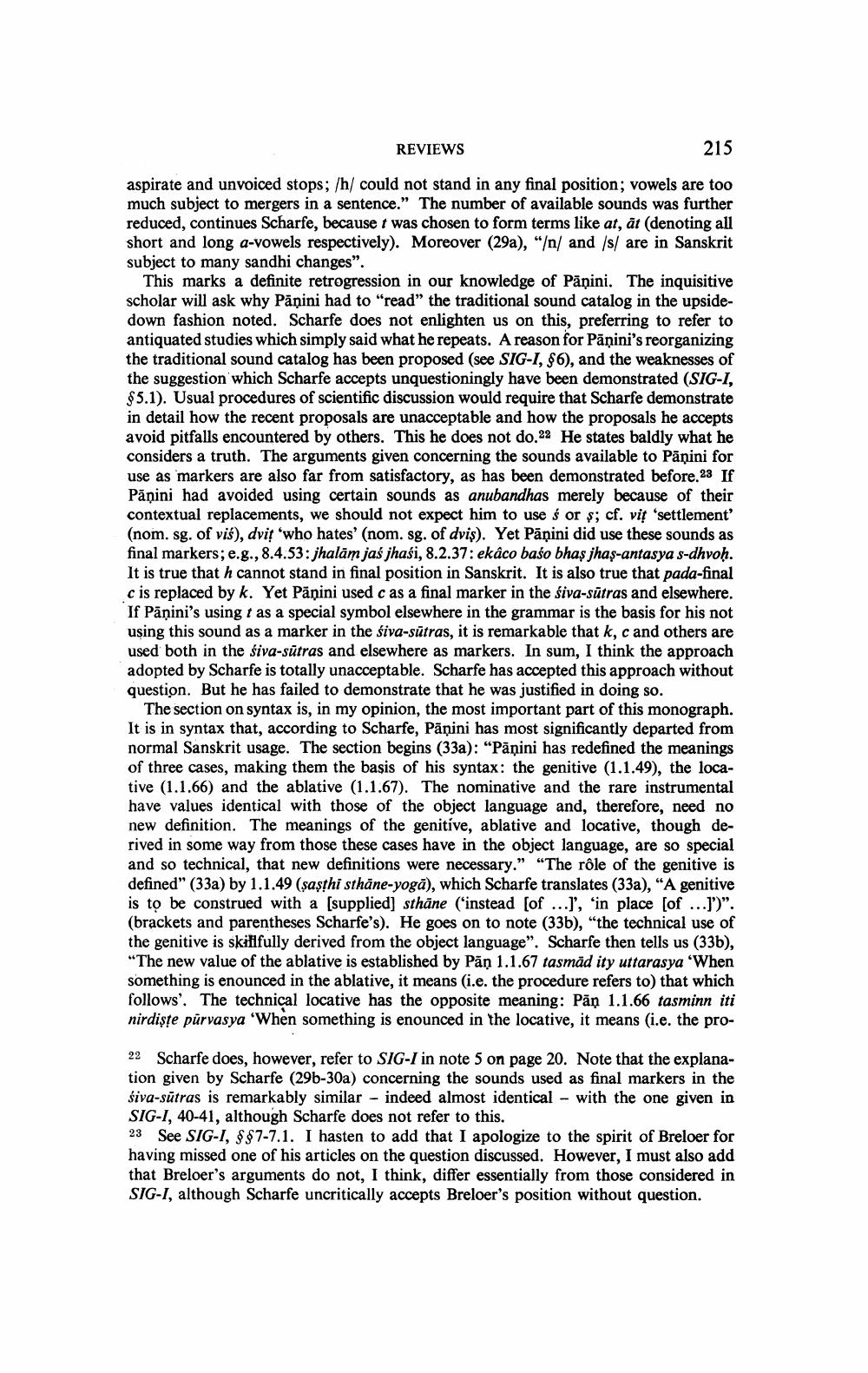________________ REVIEWS 215 ; cf. vit set avis). Yet Panin halam jas iho aspirate and unvoiced stops; // could not stand in any final position; vowels are too much subject to mergers in a sentence." The number of available sounds was further reduced, continues Scharfe, because t was chosen to form terms like at, at (denoting all short and long a-vowels respectively). Moreover (29a), "/n/ and /s/ are in Sanskrit subject to many sandhi changes". This marks a definite retrogression in our knowledge of Panini. The inquisitive scholar will ask why Panini had to "read" the traditional sound catalog in the upsidedown fashion noted. Scharfe does not enlighten us on this, preferring to refer to antiquated studies which simply said what he repeats. A reason for Panini's reorganizing the traditional sound catalog has been proposed (see SIG-I, 96), and the weaknesses of the suggestion which Scharfe accepts unquestioningly have been demonstrated (SIG-I, $5.1). Usual procedures of scientific discussion would require that Scharfe demonstrate in detail how the recent proposals are unacceptable and how the proposals he accepts avoid pitfalls encountered by others. This he does not do.22 He states baldly what he considers a truth. The arguments given concerning the sounds available to Panini for use as markers are also far from satisfactory, as has been demonstrated before.23 If Panini had avoided using certain sounds as anubandhas merely because of their contextual replacements, we should not expect him to use s or s; cf. vit 'settlement (nom. sg. of vis), dvit 'who hates' (nom. sg. of dvis). Yet Panini did use these sounds as final markers; e.g., 8.4.53: jhalam jas jhasi, 8.2.37: ekaco baso bhas jhas-antasya s-dhvoh. It is true that h cannot stand in final position in Sanskrit. It is also true that pada-final c is replaced by k. Yet Panini used cas a final marker in the siva-sutras and elsewhere. If Panini's using t as a special symbol elsewhere in the grammar is the basis for his not using this sound as a marker in the siva-sutras, it is remarkable that k, cand others are used both in the siva-sutras and elsewhere as markers. In sum, I think the approach adopted by Scharfe is totally unacceptable. Scharfe has accepted this approach without question. But he has failed to demonstrate that he was justified in doing so. The section on syntax is, in my opinion, the most important part of this monograph. It is in syntax that, according to Scharfe, Panini has most significantly departed from normal Sanskrit usage. The section begins (33a): "Panini has redefined the meanings of three cases, making them the basis of his syntax: the genitive (1.1.49), the locative (1.1.66) and the ablative (1.1.67). The nominative and the rare instrumental have values identical with those of the object language and, therefore, need no new definition. The meanings of the genitive, ablative and locative, though derived in some way from those these cases have in the object language, are so special and so technical, that new definitions were necessary." "The role of the genitive is defined" (33a) by 1.1.49 (sasthi sthane-yoga), which Scharfe translates (33a), "A genitive is to be construed with a [supplied) sthane ('instead [of ...]', 'in place (of ...]')". (brackets and parentheses Scharfe's). He goes on to note (33b), "the technical use of the genitive is skillfully derived from the object language". Scharfe then tells us (33b), "The new value of the ablative is established by Pan 1.1.67 tasmad ity uttarasya 'When something is enounced in the ablative, it means (i.e. the procedure refers to) that which follows'. The technical locative has the opposite meaning: Pan 1.1.66 tasminn iti nirdiste purvasya 'When something is enounced in the locative, it means (i.e. the pro 22 Scharfe does, however, refer to SIG-I in note 5 on page 20. Note that the explanation given by Scharfe (29b-30a) concerning the sounds used as final markers in the siva-sutras is remarkably similar - indeed almost identical - with the one given in SIG-I, 40-41, although Scharfe does not refer to this. 23 See SIG-I, $$ 7-7.1. I hasten to add that I apologize to the spirit of Breloer for having missed one of his articles on the question discussed. However, I must also add that Breloer's arguments do not, I think, differ essentially from those considered in SIG-I, although Scharfe uncritically accepts Breloer's position without question.




